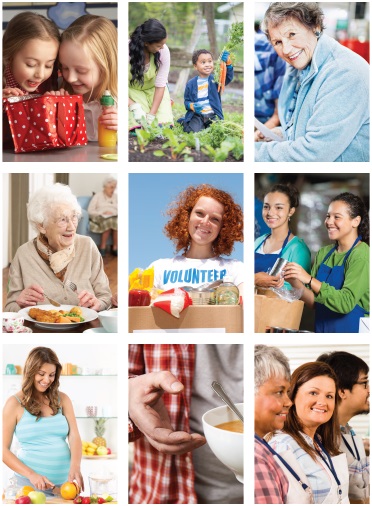Monitoring food affordability in Hamilton

Eating Well in the City of Hamilton
Not all Hamilton residents can afford a basic, healthy diet. The Guide is maintained by Red Book Community Information and lists places where providers can refer clients to receive free or low-cost food.
Hamilton Public Health uses the Ontario Nutritious Food Basket (ONFB) to survey food prices in a sample of grocery stores across the city. The results of the ONFB survey are used to determine if food is affordable for Hamiltonians.
The cost of the ONFB is calculated based on the average lowest cost of 61 food items in stores surveyed. The items on the survey are based on Canada’s Food Guide (vegetables and fruit, whole grain foods and protein foods) and reflect Canadian eating and purchasing patterns.
The ONFB does not include certain types of food and other items such as:
| Group | Age (Years) | $/Week |
|---|---|---|
| Boys | 2 to 3 | 40.62 |
| Boys | 4 to 8 | 46.13 |
| Girls | 2 to 3 | 40.62 |
| Girls | 4 to 8 | 45.59 |
| Males | 9 to 13 | 59.82 |
| Males | 14 to 18 | 82.67 |
| Males | 19 to 30 | 82.94 |
| Males | 31 to 50 | 78.38 |
| Males | 51 to 70 | 68.87 |
| Males | Over 70 | 64.04 |
| Females | 9 to 13 | 59.15 |
| Females | 14 to 18 | 70.85 |
| Females | 19 to 30 | 64.45 |
| Females | 31 to 50 | 63.39 |
| Females | 51 to 70 | 58.21 |
| Females | Over 70 | 55.73 |
| Pregnant | Under 19 | 83.65 |
| Pregnant | 19 to 30 | 82.88 |
| Pregnant | 31 to 50 | 82.57 |
| Breastfeeding | Under 19 | 81.34 |
| Breastfeeding | 19 to 30 | 79.49 |
| Breastfeeding | 31 to 50 | 72.84 |
| Reference Family of Four | Two adults 31 to 50, boy 14 & girl 8 | 270.03 |
The cost of the ONFB and rental housing can be compared to individual and family incomes to determine whether food is affordable.
Some households have very little money left after paying for rent and food which makes it hard for them to afford other expenses. Low income households are often forced to choose between buying groceries and other necessities such as:
Household scenarios comparing income to monthly expenses in Hamilton
Food Insecurity in Hamilton
Hamiltonians living with food insecurity may:
Who experiences food insecurity?
- In 2021, just over half (51.9%) of Canadians living in the 10 provinces living with food insecurity reported employment as their main source of income. Low-waged jobs and inconsistent work leave too many workers without enough income to buy food.
- Among Ontarians who receive social assistance, approximately two-thirds (67.2%) reported food insecurity in 2021. The high rates of food insecurity among households receiving social assistance in Ontario suggest that it fails to meet recipients’ basic needs.
- Reference: Tarasuk V, Li T, Fafard St-Germain AA. (2022) Household food insecurity in Canada, 2021. Toronto: Research to identify policy options to reduce food insecurity (PROOF). Retrieved from https://proof.utoronto.ca/.
The negative impacts of food insecurity
- Food insecurity is a serious public health problem because individuals’ health and well-being are closely linked to household food insecurity.
- People living in food insecure households are much more likely than others to be diagnosed with mental health disorders, chronic diseases (such as high blood pressure and diabetes) and infections. People who are food insecure are less able to manage chronic conditions and are more likely to experience poor outcomes including hospitalization or premature death. Because of its harmful effects on health, household food insecurity causes a large burden on the health care system.
- Reference: Food Insecurity Policy Research (PROOF). What are the implications of food insecurity for health and health care? https://proof.utoronto.ca/food-insecurity/what-are-the-implications-of-food-insecurity-for-health-and-health-care/
Taking action on food insecurity
Food insecurity is the result of not having enough money to buy food.
Food programs such as food banks, community fridges and community gardens may provide short-term relief for people experiencing food insecurity. Some of these programs also offer other supports and services. For information on programs and services in Hamilton, please refer to the Hamilton Food Access Guide.
Long-term solutions are needed to address the root cause of food insecurity, which is lack of money to buy enough food. Policies, tax benefits, and programs that help people afford the costs of living are needed. These include:
- Income support programs such as Ontario Works, Ontario Disability Support Program, Employment Insurance , Guaranteed Annual Income System for seniors that provide adequate benefits and are indexed to inflation
- Jobs that pay living wages
- A basic income guarantee
- Accessing government benefits such as the Canada Child Benefit, Ontario Trillium Benefit, GST/HST tax benefit, and Canada Worker Benefit through free income tax filing support

